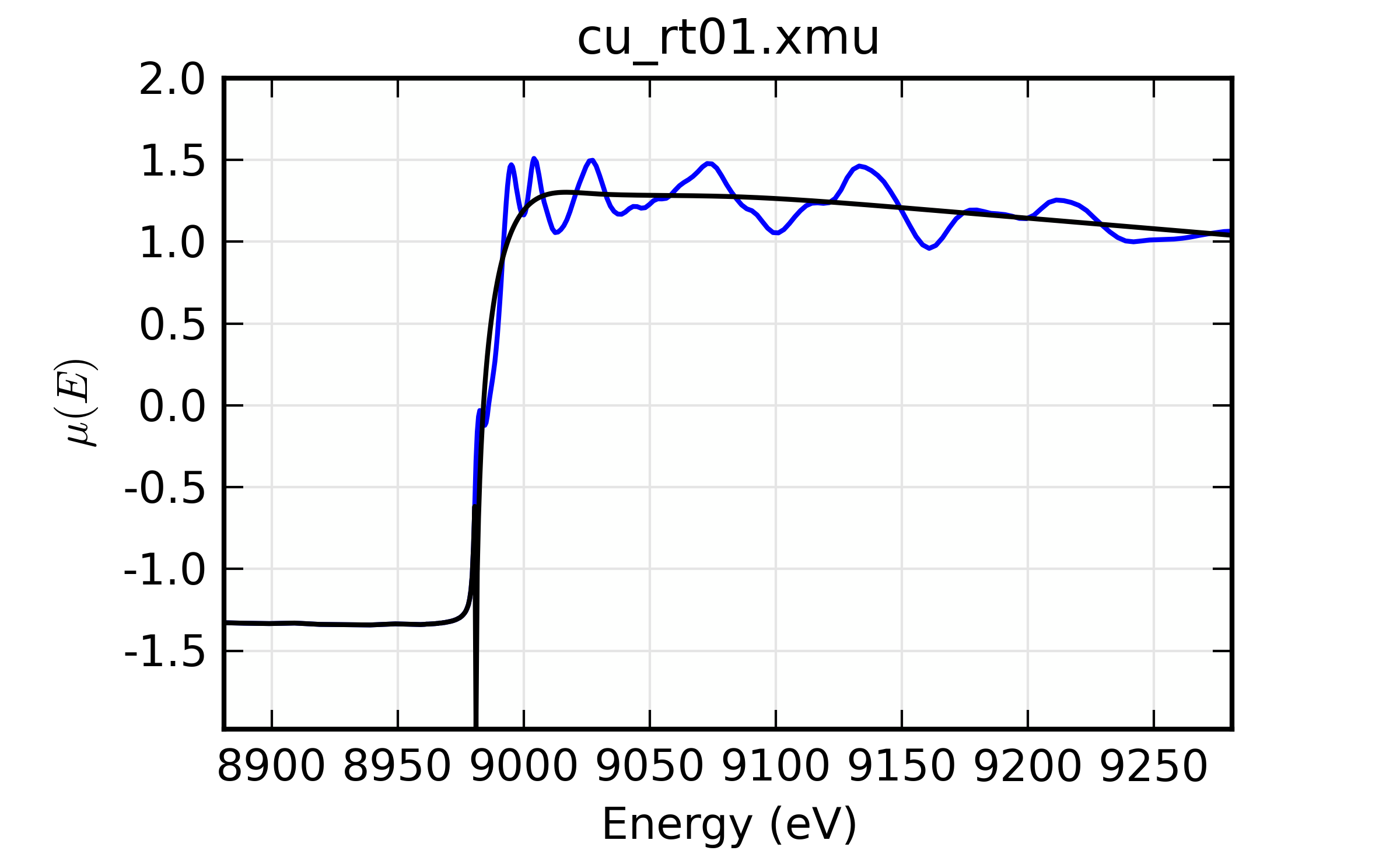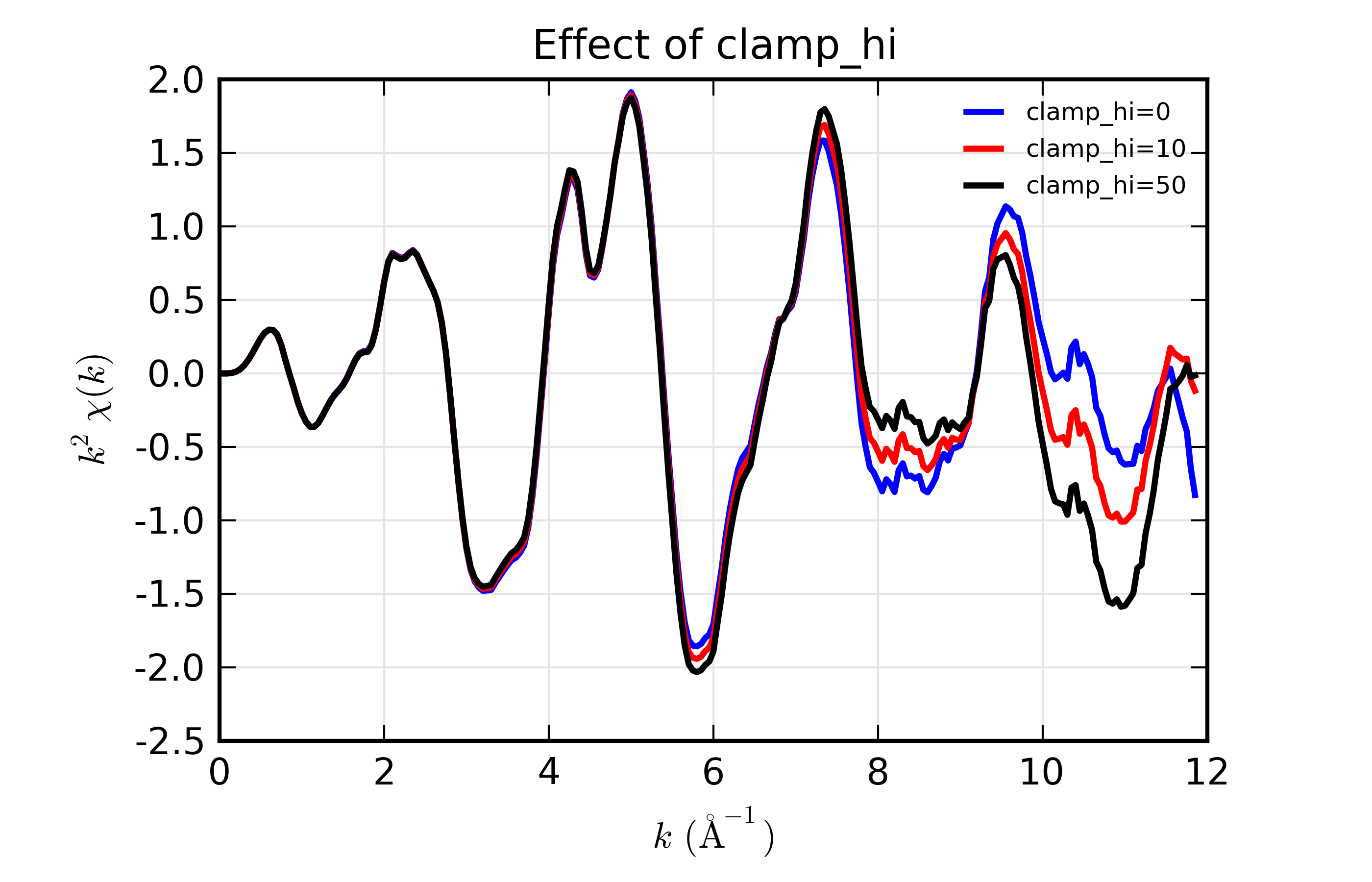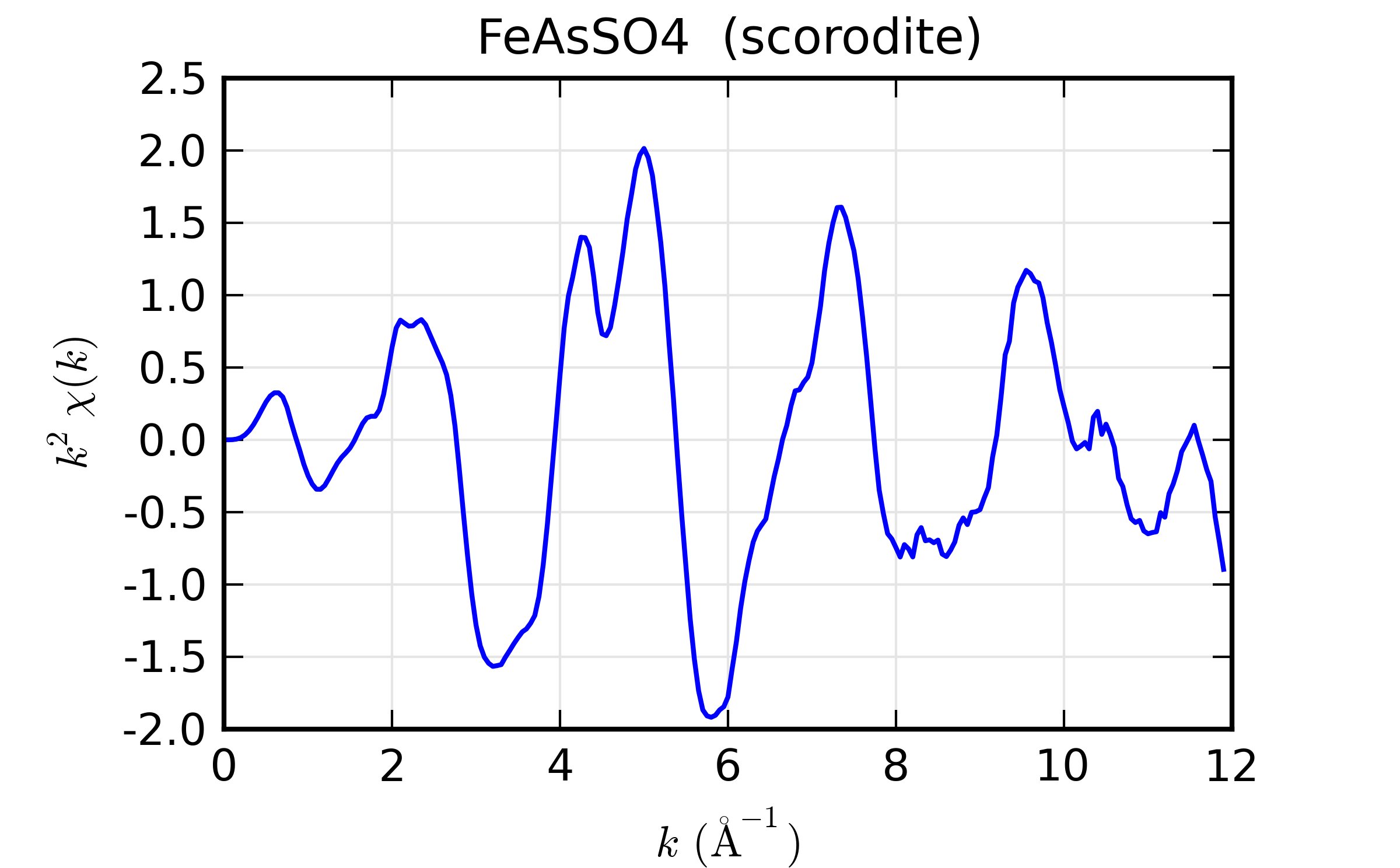13.4. XAFS: Post-edge Background Subtraction¶
Background subtraction is one of the most important data processing steps
in EXAFS analysis, converting the measured \(\mu(E)\) into the
\(\chi(k)\) ready for quantitative analysis. In Larch, this step is
performed by the autobk() function, which has many options and
subtleties. This section is devoted to background subtraction with the
autobk() function and the underlying algorithm it uses.
13.4.1. The autobk() function¶
-
autobk(energy, mu=None, group=None, rbkg=1.0, ...)¶ Determine the post-edge background function, \(\mu_0(E)\), and corresponding \(\chi(k)\).
- Parameters
energy – 1-d array of x-ray energies, in eV
mu – 1-d array of \(\mu(E)\)
group – output group (and input group for
e0andedge_step).rbkg – distance (in \(\rm\AA\)) for \(\chi(R)\) above which the signal is ignored. Default = 1.
e0 – edge energy, in eV. If None, it will be determined.
edge_step – edge step. If None, it will be determined.
pre_edge_kws – dictionary containing keyword arguments to pass to
pre_edge().nknots – number of knots in spline. If None, it will be determined.
kmin – minimum \(k\) value [0]
kmax – maximum \(k\) value [
None, full data range].kweight – \(k\) weight for FFT. [1]
dk – FFT window window parameter. [0.1]
win – FFT window function name. [‘hanning’]
nfft – array size to use for FFT [2048]
kstep – \(k\) step size to use for FFT [0.05]
k_std – optional \(k\) array for standard \(\chi(k)\) [
None]chi_std – optional \(\chi\) array for standard \(\chi(k)\) [
None]nclamp – number of energy end-points for clamp [2]
clamp_lo – weight of low-energy clamp [1]
clamp_hi – weight of high-energy clamp [1]
calc_uncertaintites – Flag to calculate uncertainties in \(\mu_0(E)\) and \(\chi(k)\) [
True]err_sigma – sigma level for uncertainties in mu_0(E) and chi(k) [1]
- Returns
None.
Follows the First Argument Group convention, using group members named
energyandmu. The following data is put into the output group:attribute
meaning
bkg
array of \(\mu_0(E)\) (not normalized)
chie
array of \(\chi(E)\) values.
k
array of \(k\) values, on uniform grid.
chi
array of \(\chi(k)\) values, the EXAFS.
delta_chi
array of uncertainty in \(\chi(k)\).
delta_bkg
array of uncertainty in \(\mu_0(E)\).
autobk_details
Group of arrays with autobk details.
Here, the arrays
group.k,group.chiwill be the same length, giving \(\chi(k)\) from 0 to a maximum k value set bykmaxor the range of available data. The arraysgroup.bkgandgroup.chiewill correspond to the inputenergyarray.The parameters
e0andedge_stepare needed to determine \(\chi(k)\), and can be specified here. If they are not, but the inputgrouphas attributese0andedge_step– say, from runningpre_edge()– those values will be used. If values cannot be found in either place, they will be determined by callingpre_edge()from withinautobk(), and the output parameters frompre_edge()will be added to the outputgrouphere. Thepre_edge_kwsargument can be used here to hold a dictionary of parameters to pass topre_edge().If
calc_uncertaintiesis set toTrue, the outputsgroup.delta_chiandgroup.delta_bkg, holding the uncertainties in \(\chi(k)\) and \(\mu_0(E)\), respectively. These calculations are relatively costly, and can take 20 times longer to determine \(\chi(k)\) and \(\mu_0(E)\) themselves.The
group.autobk_detailsgroup will contain the following attributes:attribute
meaning
spline_pars
Parameters used for determining \(\mu_0(E)\) spline.
init_bkg
Initial value for \(\mu_0(E)\)
init_chi
Initial value for \(\chi(k)\)
knots_e
Spline knot energies
knots_y
Spline knot values
init_knots_y
Initial Spline knot values
13.4.2. The AUTOBK Algorithm¶
The background subtraction method used is the AUTOBK algorithm (see [Newville et al. (1993)]), in which a spline function is matched to the low-R components of the resulting \(\chi(k)\).
For reference, \(k = \sqrt{2m_e (E-E_0)/\hbar^2}\) is the wavenumber of the ejected photo-electron, where \(E_0\) is the absorption threshold energy (the 0 of photo-electron energy). For \(k\) in units of \(\rm \AA^{-1}\) and \(E\) in units of eV, \(k \approx \sqrt{(E-E_0)/3.81}\). With this conversion of energy to wavenumber, \(\chi(k)\) is defined from
\(\chi(E) = \frac{\mu(E)-\mu_0(E)}{\Delta\mu}\)
where \(\mu_0(E)\) represents the idealized x-ray absorption of a bare atom, embedded in the molecular or solid environment, but without scattering of the outgoing photo-electron that gives rise to the EXAFS, and \(\Delta\mu\) is the edge step in \(\mu(E)\).
The quantity \(\mu_0(E)\) cannot be independently measured. Instead, we empirically determine it here given the dxta for \(\mu(E)\) by fitting a spline (a piece-polynomial function that is easily adjusted even while its smoothness is controlled) to \(\mu(E)\). An advantage to what could easily be described as an ad hoc approach is that the data for \(\mu(E)\) can include many systematic drifts and dependencies that are slowly varying with energy.
The definition above normalizes to the edge step \(\Delta\mu\)
(edge_step) instead of the energy-dependent \(\mu_0(E)\), as is
often described in introductory texts on EXAFS. The reason for this is
essentially the same – so that we do not need to carefully take care of
slow energy drifts in the measured \(\mu(E)\) or worry about having an
absolute measure of \(\mu(E)\).
13.4.2.1. \(R_{\rm bkg}\) and spline for \(\mu_0(E)\)¶
A spline is a general mathematical function, and so using one to match \(\mu(E)\) that we will subtract from the same \(\mu(E)\) could easily match too well, and erase much of the data we’re interested in. Therefore, we have to carefully consider two aspects:
what portions of the spectrum we want it to match, and
how flexible the spline can be.
What we want is a \(\mu_0(E)\) that removes the low frequency (low-R) portions of the \(\chi\) spectra, and recognizing this can tell us how to determine both of these.
First, since we know the EXAFS oscillations do not extend far below the
near-neighbor distance and since atoms are essentially never closer than 1
\(\rm\AA\), and generally more like 2 \(\rm\AA\), we can say that
we want to remove the frequencies of \(\chi\) below some distance,
\(R_{\rm bkg}\) (rbkg). That is, we want the spline function to
be adjusted so that the components of \(\chi(R)\) below \(R_{\rm
bkg}\) are minimized. We can use a default of 1 \(\rm\AA\), and
recommend that the value be roughly half the expected near-neighbor
distance.
To do this, we create a spline function consisting of \(N_{\rm knots}\) adjustable points (knots in the spline, where the second derivatives are allowed to change), evenly spaced in \(k\) (that is, quadratic in energy). We do a fit that adjusts the values of the function at each knot, computes \(\mu_0(E)\) by simple spline interpolation, calculates \(\chi(k)\), does a Fourier transform to \(\chi(R)\), and then seeks to minimize the components of \(\chi(R)\) below \(R_{\rm bkg}\).
This leads to the second question of how flexible to make the spline is answered from basic signal processing through the Nyquist-Shannon sampling theorem, which tells us how many adjustable parameters to use for our spline:
where \(\Delta k\) is the \(k\) range of the data. This value can
be over-ridden by specifing nknots, but this is strongly recommended
against.
In this way we satisfy both considerations above: limiting the number of knots prevents the spline from being able to follow the frequencies of \(\chi(k)\) we care about most, and limiting the portion of the spectrum to be minimized to the very low-\(R\) components, we do not even try to match those frequencies. Thus, we are ensured of a \(\mu_0(E)\) that only removes the low-\(R\) components of \(\chi\).
13.4.2.2. Selecting Fourier transform parameters¶
In order to determine \(\mu_0(E)\), we must do a Fourier transform. These are discussed in more detail in the next section, but here we give the parameters affecting the Fourier transform used, and their default values.
argument
meaning
default, recommended values
kmin
\(k_{\rm min}\)
should be below 1.0
kmax
\(k_{\rm max}\)
highest \(k\) value. Useful data range.
kweight
\(kw\)
should be 0 or 1 (but not > 2)
win
window function name
Hanning, Parzen works well too.
dk
window sill size
should be 0 or 1
nfft
FFT array size
No reason to change this.
kstep
\(k\) step size
0.05. No reason to change this.
The most important point is that the Fourier transform used to fit
and visualize \(\chi(k)\) is not necessarily the one to use here. In
particular, the kweight parameter should be 0 or 1 here, as we want to
emphasize the low-\(k\) portion of \(\chi(k)\). The default
parameter values for autobk() are generally sufficient, and need only
minor adjustments except in unusual cases.
13.4.2.3. Using a standard \(\chi(k)\)¶
We said above that we want to minimize the low-\(R\) components of \(\chi\). In principle, there should be some leakage of the first shell to fairly low-\(R\). This is especially noticeable for a short ligand (say, below 1.75 \(\rm\AA\) or so) of a low-Z atom (notably, C, N, and O). Normally, this is not a serious problem, but it does point out that \(\mu_0(E)\) might want to leave some first-shell leakage at low-\(R\).
To accout for this, you can proved a spectrum of \(\chi(k)\) for a
standard that is meant to be close to the spectrum being analyzed. This is
done by providing 2 arrays: k_std and chi_std, which need to be the
same lenth. By providing these, the best values for \(\mu_0(E)\) will
be those that minimize the Fourier transorm of the difference of
\(\chi(k)\) for the data and standard. This can be especially helpful
to give more consistent background for a set of related spectra.
13.4.2.4. End-point clamps for the spline¶
Because the spline is chosen to match the low-\(R\) components of \(\chi\), the process does not even look at how the resulting \(\mu_0(E)\) looks. This can lead to some unstable behavior at the end-points of the spline, causing \(\chi(k)\) to diverge at the ends.
This can be remedied by adding clamps to the end-points of \(chi(k)\) to the fit. That is, a few points at the low- and high-ends of the \(\chi(k)\) array are appended to the array to be minimized in the fit, which has the tendency to push the end-points of \(\chi(k)\) to zero.
There are three parameters influencing these end-points clamps. nclamp
sets the number of data points of \(\chi(k)\) at the beginning and end
of the \(k\) range to add to the fit. clamp_lo sets the weighting
factor applied to the first nclamp points for the low-\(k\) end fo
the data range, and clamp_hi sets the weighting factor applied to the
last nclamp points at the high-\(k\) end.
There is not an easy way to determine ahead of time what the clamp
parameters will be. Typically, nclamp need only be 1 to 5 data points
(with 2 being the default). Setting nclamp to 0 will remove the clamps
completely. Values for clamp_lo and clamp_hi are floating point
numbers, and should range from about 1 (the default) to 10 or 20 for a very
strong clamp that will almost certainly force \(\chi(k)\) to be 0 at
the end-points.
13.4.2.5. Recommendations¶
Here, we give a few recommendations on what parameters most affect the background subtraction. These parameters are (in roughly increasing order):
0.
rbkg: This is the main parameter that sets how flaexible the spline function can be.1.
e0: It can be hard to know what \(E_0\) should be for any XAFS spectra. As this sets the value of \(k=0\), it will affect the location of the knots, and can have a profound affect on the results. If you’re unhappy with the \(\mu_0(E)\) and \(\chi(k)\), playing with thee0parameter.2.
kweight: Increasing this emphasizes the fit at high k. Trying both values of 0 and 1 is always a good idea.3.
clamp_loandclamp_hi: If \(\mu_0(E)\) swoops up or down at the endpoints too much, increasing these values can help greatly.
13.4.3. Examples¶
Here, we give a few examples using autobk(), and outline some of its
features.
13.4.3.1. Basic example¶
The simplest example of reading data and doing background subtraction would using all the default inputs would be:
## examples/xafs/doc_autobk1.lar
fname = '../xafsdata/cu_rt01.xmu'
cu = read_ascii(fname)
autobk(cu.energy, cu.mu, rbkg=1.0, group=cu)
plot_bkg(cu, emin=-100, emax=400)
plot_chik(cu, kweight=1, win=2)
## end of examples/xafs/doc_autobk1.lar
with the resulting outputs looking like this:

Figure 13.4.3.1 \(\mu(E)\) and background \(\mu_0(E)\)¶

Figure 13.4.3.2 resulting \(k\chi(k)\)¶
Example of simple usage of autobk() for Cu metal.
Thus demonstrating that we can process data on Cu metal.
For a slightly more challenging example, we try the As K-edge of scorodite
(\(\rm FeAsO4 \cdot (nH_2O)\)). Here, we start by reading in data and
constructing \(\mu(E)\), then run autobk(). We take most of the
default values for pararmeters, but pass explicit parameters such as
nnorm to pre_edge() using pre_edge_kws. Setting these
parameters is not critically important for this data set, and is mostly
here to demonstrate the method for passing arguments to pre_edge().
## examples/xafs/doc_autobk2.lar
fname = '../xafsdata/scorodite_as_xafs.001'
title = 'FeAsSO4 (scorodite)'
dat = read_ascii(fname)
dat.mu = ln(dat.i0/dat.i1)
autobk(dat.energy, dat.mu, rbkg=1.0, group=dat)
plot_bkg(dat, emin=-150)
plot_chik(dat, kweight=2, win=2)
## end of examples/xafs/doc_autobk2.lar
The resulting outputs looks OK:
A close examimation of \(k^2\chi(k)\) suggests we might be able to do better, which brings us to the next section.
13.4.3.2. Adjusting spline clamps¶
For the scorodite example above, the XAFS diverges from 0 at the high-\(k\) end of the spectra. Playing with the spline clamps discussed above, we try a few options to study the effect of adding a clamp:
## examples/xafs/doc_autobk3.lar
fname = '../xafsdata/scorodite_as_xafs.001'
title = 'FeAsSO4 (scorodite)'
dat = read_ascii(fname)
dat.mu = ln(dat.i0/dat.i1)
autobk(dat.energy, dat.mu, rbkg=1.0, group=dat, clamp_hi=0)
dat.chi0 = dat.chi * dat.k**2
dat.bkg0 = dat.bkg
autobk(dat.energy, dat.mu, rbkg=1.0, group=dat, clamp_hi=10)
dat.chi10 = dat.chi * dat.k**2
dat.bkg10 = dat.bkg
autobk(dat.energy, dat.mu, rbkg=1.0, group=dat, clamp_hi=50)
dat.chi50 = dat.chi * dat.k**2
dat.bkg50 = dat.bkg
newplot(dat.k, dat.chi0, label='clamp_hi=0', show_legend=True,
xlabel=r'$k \rm\, (\AA^{-1})$', ylabel=r'$k^2\chi(k)$',
title='Effect of clamp_hi')
plot(dat.k, dat.chi10, label='clamp_hi=10', show_legend=True)
plot(dat.k, dat.chi50, label='clamp_hi=50', show_legend=True)
## end of examples/xafs/doc_autobk3.lar
results in the following comparison:

Figure 13.4.3.3 Influence of spline clamps of \(\chi(k)\)¶
13.4.3.3. Using a Standard \(\chi(k)\)¶
Since the EXAFS contribution from the first shell is not perfectly isolated
in \(R\), it can leak into portion of \(\chi(R)\) below
\(R_{\rm bkg}\). It may be desirable to not simply reduce the portion
of \(\chi(R)\) below \(R_{\rm bkg}\), but to account for the
expected leakage from the first shell. To do this, you can provide a
standard \(\chi(k)\) spectrum that will simulate the first shell by
specify arrays for k_std and chi_std arrays to the autobk()
function.
As an example:
## examples/xafs/doc_autobk4.lar
fname = '../xafsdata/cu.xmu'
chi_fname = '../xafsdata/cu10k.chi'
cu1 = read_ascii(fname)
chidat = read_ascii(chi_fname, labels='k chi')
pre_edge(cu1.energy, cu1.mu, group=cu1)
cu2 = copy(cu1)
autobk(cu1.energy, cu1.mu, rbkg=1, group=cu1)
# now with std...
autobk(cu2.energy, cu2.mu, rbkg=1, group=cu2, k_std=chidat.k, chi_std=chidat.chi)
plot_chik(cu1, kweight=2, label='no std')
plot_chik(cu2, kweight=2, label='with std', new=False)
## end of examples/xafs/doc_autobk4.lar
References
- Newville et al. (1993)
M. Newville, P. Livins, Y. Yacoby, J. J. Rehr, and E. A. Stern. Near-edge x-ray-absorption fine structure of Pb: A comparison of theory and experiment. Physical Review B, 47(21):14126–14131, 1993. doi:10.1103/PhysRevB.47.14126.


